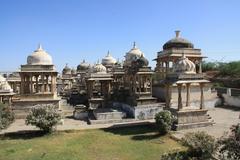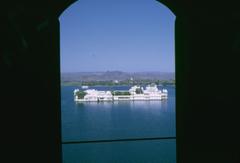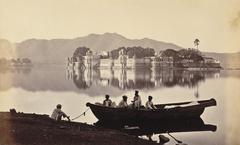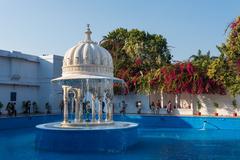Visiting Gangaur Ghat: Hours, Tickets, and Historical Insights
Date: 18/08/2024
Introduction
Gangaur Ghat, also known as Gangori Ghat, stands as one of Udaipur’s most iconic historical and cultural landmarks. Nestled on the scenic banks of Lake Pichola, this ghat is deeply entrenched in the rich cultural fabric of Rajasthan. Historically, its origins can be traced back to the medieval period during the reign of the Mewar dynasty, which ruled the region from the 8th to the 16th century. The ghat derives its name from the Gangaur festival, a significant local festival celebrated in honor of Goddess Gauri, a manifestation of Parvati, the consort of Lord Shiva (Rajasthan Tour Planner) (Rajasthan GK Online). Over time, Gangaur Ghat has evolved from a royal ceremonial site to a communal space where people from all walks of life participate in various cultural activities. Its architectural beauty, coupled with its pivotal role in local festivals, makes it a must-visit destination for both locals and tourists alike. This comprehensive guide delves into the historical origins, cultural significance, visitor information, and more, offering a thorough understanding of why Gangaur Ghat remains a cherished landmark in Udaipur.
Exploring Gangaur Ghat: History, Visiting Hours, and Cultural Significance in Udaipur
Origins and Early History
Gangaur Ghat is a significant historical and cultural landmark located on the banks of Lake Pichola in Udaipur, Rajasthan. The origins of Gangaur Ghat can be traced back to the medieval period, specifically during the reign of the Mewar dynasty, which ruled the region from the 8th to the 16th century. The ghat was named after the Gangaur festival, one of the most important local festivals in Rajasthan, celebrated in honor of Goddess Gauri, a manifestation of Parvati, the consort of Lord Shiva (Rajasthan Tour Planner).
Evolution Over Time
Initially, the Gangaur festival was celebrated primarily by the royal women of the Mewar dynasty, who would gather at the ghat to perform rituals and prayers for the well-being and longevity of their husbands. Over time, the festival and the ghat itself gained popularity among the masses, becoming an integral part of Udaipur’s cultural and social fabric. The ghat evolved from a royal ceremonial site to a communal space where people from all walks of life could participate in the festivities (Rajasthan GK Online).
Cultural Significance
Gangaur Ghat holds immense cultural significance in Udaipur and Rajasthan as a whole. It serves as the focal point for the Gangaur festival, which is celebrated with great fervor and enthusiasm. The festival, lasting for 18 days, involves various rituals, including the ceremonial procession of idols of Gan (Shiva) and Gauri (Parvati) from the City Palace to the ghat. These idols are then immersed in Lake Pichola, symbolizing the union of Shiva and Parvati and the renewal of life (Wikipedia).
Architectural and Aesthetic Appeal
The architectural design of Gangaur Ghat is a testament to the rich heritage of Udaipur. The ghat is adorned with intricate carvings and traditional Rajasthani motifs, reflecting the artistic prowess of the craftsmen of that era. The serene ambiance of the ghat, coupled with its picturesque location by Lake Pichola, makes it a popular spot for both locals and tourists. The ghat is particularly enchanting during the evenings when the surrounding streets and houses are illuminated, creating a magical atmosphere (Rajasthan Tour Planner).
Role in Festivals and Celebrations
Apart from the Gangaur festival, Gangaur Ghat plays a vital role in other local festivals and religious ceremonies. One such festival is Jal-Jhulni Ekadashi, during which the idols of Bal Gopal (Lord Krishna in his child form) are brought to the ghat in a colorful procession. The idols are then swung in the waters of Lake Pichola, a ritual believed to seek blessings from Lord Krishna. This festival, like Gangaur, attracts a large number of devotees and tourists, adding to the ghat’s cultural vibrancy (Rajasthan Tour Planner).
Modern-Day Relevance
In contemporary times, Gangaur Ghat continues to be a hub of cultural activities and a popular tourist destination. The ghat serves multiple purposes, including being a place of worship, a venue for cultural events, and a recreational spot for locals and tourists alike. The ghat’s strategic location in the heart of Udaipur, near the Jagdish Chowk area, makes it easily accessible from various parts of the city. Despite the challenges of navigating the narrow streets leading to the ghat, its allure remains undiminished (My Udaipur City).
Visitor Information
For those planning to visit Gangaur Ghat, here are some essential details:
- Visiting Hours: Gangaur Ghat is open to the public 24 hours a day, but it is best visited during the early morning or late evening for a serene experience.
- Tickets: There is no entry fee to visit the ghat. However, some special events or cultural programs may have ticketed entry.
- Travel Tips: Wear comfortable footwear as the streets leading to the ghat can be narrow and crowded. Also, be respectful of the local customs and traditions, especially during festivals.
- Accessibility: The ghat is accessible by foot from Jagdish Chowk. Due to the narrow streets, it is advisable to use local transport like auto-rickshaws.
- Best Time to Visit: The best time to visit Gangaur Ghat is during the Gangaur festival in March-April or during the Jal-Jhulni Ekadashi in September.
Preservation and Conservation Efforts
Efforts have been made to preserve and maintain the historical and cultural integrity of Gangaur Ghat. Various local and state government initiatives aim to protect the ghat’s architectural heritage while promoting it as a tourist attraction. These efforts include regular maintenance, restoration of damaged structures, and organizing cultural events to keep the traditions alive. The ghat’s preservation is crucial not only for its historical significance but also for its role in sustaining the cultural heritage of Udaipur (Rajasthan GK Online).
Visitor Experience
For visitors, Gangaur Ghat offers a unique blend of history, culture, and natural beauty. The ghat provides a tranquil setting where tourists can relax and soak in the scenic views of Lake Pichola. It is also an excellent spot for photography, especially during the festivals when the ghat is adorned with colorful decorations and bustling with activity. Tourists can also explore nearby attractions such as the Bagore-ki-Haveli, a historic mansion turned museum that showcases the rich cultural heritage of Rajasthan (Wikipedia).
FAQ
- What are the visiting hours for Gangaur Ghat? Gangaur Ghat is open 24 hours a day, but early morning and late evening are the best times to visit.
- Is there an entry fee for Gangaur Ghat? No, there is no entry fee, but special events may require tickets.
- What is the best time to visit Gangaur Ghat? The best time to visit is during the Gangaur festival in March-April or Jal-Jhulni Ekadashi in September.
Conclusion
Gangaur Ghat stands as a symbol of Udaipur’s rich cultural heritage and historical legacy. Its evolution from a royal ceremonial site to a communal space for cultural celebrations highlights its enduring significance in the lives of the people of Udaipur. As a focal point for major festivals and a popular tourist destination, Gangaur Ghat continues to captivate visitors with its architectural beauty, cultural vibrancy, and serene ambiance. Efforts to preserve and promote this historical landmark ensure that it remains a cherished part of Udaipur’s cultural landscape for generations to come.
For more information on other historical sites in Udaipur and to stay updated on local events, download the Audiala mobile app, check out related posts, and follow us on social media.
References
- Gangaur Ghat: History, Visiting Hours, and Cultural Significance in Udaipur, 2024, Rajasthan Tour Planner https://www.rajasthantourplanner.com/blog/gangaur-ghat/
- History of Gangaur: The Divine Festival of Rajasthan, 2024, Rajasthan GK Online https://rajasthangkonline.com/history-of-gangaur-the-divine-festival-of-rajasthan/
- Gangaur Ghat, 2024, My Udaipur City https://myudaipurcity.com/gangaur-ghat-udaipur/
- Gangaur Ghat, 2024, Wikipedia https://en.wikipedia.org/wiki/Gangaur_Ghat
- Gangaur Festival: Meaning, Significance, Mythological Roots, and Celebration, 2024, Pratha Cultural School https://www.prathaculturalschool.com/post/gangaur-festival-meaning-significance-mythological-roots-and-celebration
- Gangaur Ghat: The Spiritual Oasis of Udaipur, 2024, Indian Culture https://indianculture.com/gangaur-ghat-the-spiritual-oasis-of-udaipur/
- Gangaur Ghat in Udaipur, 2024, WanderOn https://wanderon.in/blogs/gangaur-ghat-in-udaipur
- Gangaur Ghat: Visitor Tips and Information, 2024, Crossroad Adventure https://www.crossroadadventure.com/gangaur-ghat-udaipur/
- Lake Pichola, Udaipur: A Travel Guide, 2024, Travel Earth https://travel.earth/lake-pichola-udaipur/
- Gangaur Ghat: Attractions and Festivals, 2024, Thrillophilia https://www.thrillophilia.com/attractions/gangaur-ghat-udaipur



